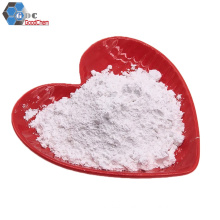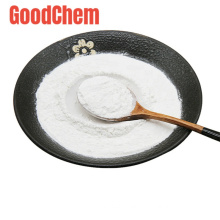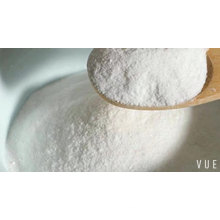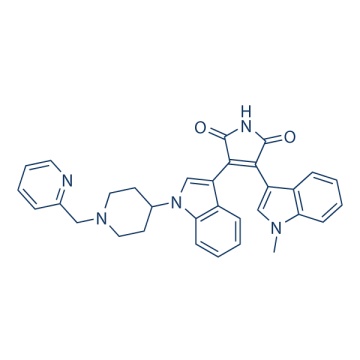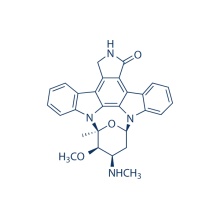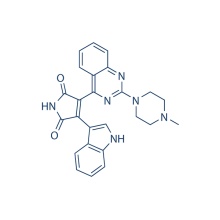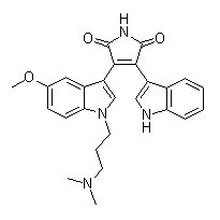Enzastaurina (LY317615)
Descripción del producto
Peso molecular: 515,61 La enzastaurina (LY317615) es un potente inhibidor selectivo de PKCβ con IC50 de 6 nM, selectividad de 6 a 20 veces contra PKCα, PKCγ y PKCε. Fase 3. \ n Actividad biológica
Protocolo (solo como referencia) Ensayo de quinasa: [1]
Ensayo celular: [1]
Estudio con animales: [1]
Conversión de diferentes modelos de animales basados en BSA (valor basado en datos del Borrador de Directrices de la FDA)
Por ejemplo, para modificar la dosis de resveratrol utilizada para un ratón (22,4 mg / kg) a una dosis basada en el BSA para una rata, multiplique 22,4 mg / kg por el factor Km para un ratón y luego divida por el factor Km para una rata. Este cálculo da como resultado una dosis equivalente para ratas de resveratrol de 11,2 mg / kg.
Información química
| Description | Enzastaurin (LY317615) is a potent PKCβ selective inhibitor with IC50 of 6 nM, 6- to 20-fold selectivity against PKCα, PKCγ and PKCε. Phase 3. | |||||
|---|---|---|---|---|---|---|
| Targets | PKCβ [1] | PKCα [1] | PKCγ [1] | PKCε [1] | ||
| IC50 | 6 nM | 39 nM | 83 nM | 110 nM | ||
| In vitro | Enzastaurin application results in a marked dose-dependent inhibition of growth in all MM cell lines investigated, including MM.1S, MM.1R, RPMI 8226 (RPMI), RPMI-Dox40 (Dox40), NCI-H929, KMS-11, OPM-2, and U266, with IC50 from 0.6-1.6 μM. Enzastaurin direct impacts human tumor cells, inducing apoptosis and suppressing proliferation in cultured tumor cells. Enzastaurin also suppresses the phosphorylation of GSK3βser9, ribosomal protein S6S240/244, and AKTThr308 while having no direct effect on VEGFR phosphorylation. [1] Enzastaurin increases apoptosis in malignant lymphocytes of CTCL. When combined with GSK3 inhibitors, enzastaurin demonstrated an enhancement of cytotoxicity levels. Treatment with a combination of enzastaurin and the GSK3 inhibitor AR-A014418 led to increased levels of β-catenin total protein and β-catenin-mediated transcription. Blocking of β-catenin-mediated transcription or small hairpin RNA (shRNA) knockdown of β-catenin induced the same cytotoxic effects as that of enzastaurin plus AR-A014418. Additionally, treatment with enzastaurin and AR-A014418 decreased the mRNA levels and surface expression of CD44. | |||||
| In vivo | Treatment of xenografts with Enzastaurin and radiation produced greater reductions in density of microvessels than either treatment alone. The decrease in microvessel density corresponded to delayed tumor growth. | |||||
| Features |
|
|||||
| Kinase inhibition assays | The inhibition of PKCβII, PKCα, PKCε, or PKCγ activity by enzastaurin is determined using a filter plate assay format measuring 33P incorporation into myelin basic protein substrate. Reactions are done in 100 μL reaction volumes in 96-well polystyrene plates with final conditions as follows: 90 mM HEPES (pH 7.5), 0.001% Triton X-100, 4% DMSO, 5 mM MgCl2, 100 μM CaCl2, 0.1 mg/mL phosphatidylserine, 5 μg/mL diacetyl glyerol, 30 μM ATP, 0.005 μCi/μL 33ATP, 0.25 mg/mL myelin basic protein, serial dilutions of enzastaurin (1-2,000 nM), and recombinant human PKCβII, PKCα, PKCε, or PKCγ enzymes (390, 169, 719, or 128 pM, respectively). Reactions are started by addition of the enzyme and incubated at room temperature for 60 minutes. They are then quenched with 10% H3PO4, transferred to multiscreen anionic phosphocellulose 96-well filter plates, incubated for 30 to 90 minutes, filtered and washed with 4 volumes of 0.5% H3PO4 on a vacuum manifold. Scintillation cocktail is added and plates are read on a Microbeta scintillation counter. IC50 values are determined by fitting a three-variable logistic equation to the 10-point dose-response data using ActivityBase 4.0. |
|---|
| Cell lines | HCT116 and U87MG cells |
|---|---|
| Concentrations | 0.3-4 μM |
| Incubation Time | 72 hours |
| Method | Induction of apoptosis by enzastaurin is measured by nucleosomal fragmentation and terminal deoxynucleotidyl transferase-mediated nick-end labeling (TUNEL) and staining in HCT116 and U87MG cell lines. Briefly, 5 × 103 cells are plated per well in 96-well plates (1% FBS-supplemented media conditions), incubated with or without Enzastaurin for 48 to 72 hours. The absorbance values are normalized to those from control-treated cells to derive a nucleosomal enrichment factor at all concentrations as per the manufacturer's protocol. The concentrations studied ranges from 0.1 to 10 μM. In situ TUNEL staining is assayed with the In situ Cell Death Detection, Fluorescein kit. Cells (7.5 ?104) are plated per well in 6-well plates and incubated 72 hours in 1% FBS-supplemented media ?Enzastaurin. Fluorescein-labeled DNA strand breaks are detected with the BD epics flow cytometer. Ten thousand, single-cell, FITC-staining events are collected for each test. |
| Animal Models | Athymic nude mice | ||
|---|---|---|---|
| Formulation | 10% acacia in water | ||
| Dosages | 75 mg/kg twice daily | ||
| Administration | By gavage | ||
| Solubility | 15% Captisol, 30 mg/mL | ||
| * Please note that Selleck tests the solubility of all compounds in-house, and the actual solubility may differ slightly from published values. This is normal and is due to slight batch-to-batch variations. | |||
| Species | Baboon | Dog | Monkey | Rabbit | Guinea pig | Rat | Hamster | Mouse |
| Weight (kg) | 12 | 10 | 3 | 1.8 | 0.4 | 0.15 | 0.08 | 0.02 |
| Body Surface Area (m2) | 0.6 | 0.5 | 0.24 | 0.15 | 0.05 | 0.025 | 0.02 | 0.007 |
| Km factor | 20 | 20 | 12 | 12 | 8 | 6 | 5 | 3 |
| Animal A (mg/kg) = Animal B (mg/kg) multiplied by | Animal B Km |
| Animal A Km |
| Rat dose (mg/kg) = mouse dose (22.4 mg/kg) × | mouse Km(3) | = 11.2 mg/kg |
| rat Km(6) |
| Molecular Weight (MW) | 515.61 |
|---|---|
| Formula |
C32H29N5O2 |
| CAS No. | 170364-57-5 |
| Storage | 3 years -20℃Powder |
|---|---|
| 6 months-80℃in solvent (DMSO, water, etc.) | |
| Synonyms |
|
| Solubility (25°C) * | In vitro | DMSO | 30 mg/mL (58.18 mM) |
|---|---|---|---|
| Water | <1 mg/mL ( | ||
| Ethanol | <1 mg/mL ( | ||
| In vivo | 15% Captisol | 30 mg/mL | |
|
|
|||
|
|
methyl-1H-indol-3-yl)-4-(1-(1-(pyridin-2-ylmethyl)piperidin-4-yl)-1H-indol-3-yl)-1H-pyrrole-2,5-dione |
|---|
| Stock Solution (1ml DMSO) | 1mM | 10mM | 20mM | 30mM |
|---|---|---|---|---|
| Mass(mg) | 0.51561 | 5.1561 | 10.3122 | 15.4683 |
Grupos de Producto : Señalización citoesquelética > Inhibidor de PKC
Otros productos
Productos hot
Astragalósido AClortetraciclina HCl 64-72-2Paclitaxel 33069-62-4Acetato de dexametasona 1177-87-3Dinaciclib (SCH727965) 779353-01-4CHIR-124 405168-58-3Ro3280 1062243-51-9TAME 901-47-3CCG-1423 285986-88-110058-F4 403811-55-2Dabigatrán (BIBR 953) 211914-51-1H 89 2HCl 130964-39-5T0901317 293754-55-9Aprepitant 170729-80-3Turofexorate Isopropil (XL335) 629664-81-9BMS-378806 357263-13-9
